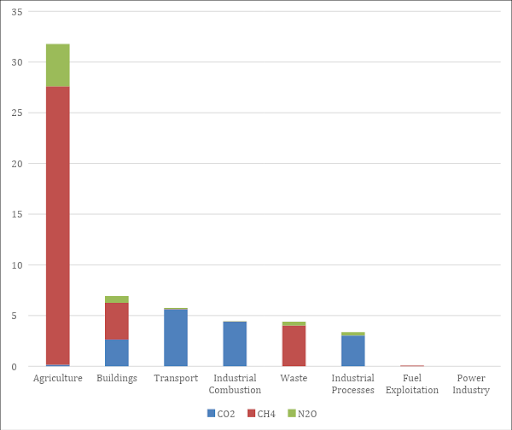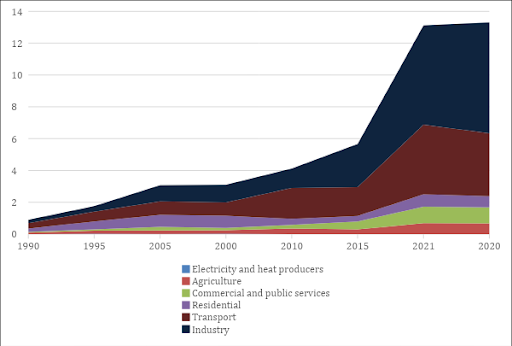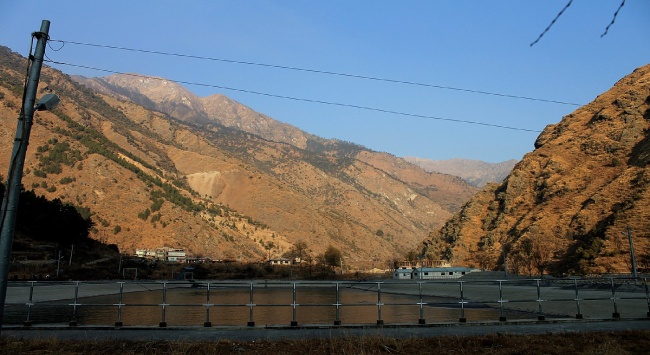Summary
To meet its ambitious climate pledge, Nepal’s major focus has been on its hydroelectricity. There are several challenges in Nepal’s overreliance on hydroelectricity. To overcome the challenges, Nepal needs meaningful financial and technical support.
Introduction
With Nepal’s share of global greenhouse gas (GHG) emissions at 0.11 per cent of the world total in 2022,[1] Nepal’s contribution to climate change is negligible. This is despite the fact that the country’s GHG emissions have grown by about 80 per cent since 1990.[2] Surely, Nepal’s emissions will rise further in the future with an increase in its economic activities and people’s incomes, if efforts are not made to curb its emissions.
Nepal has made a global commitment to achieve net-zero emissions by 2045.[3] This is ambitious compared to other countries, such as China and India’s commitments for their net-zero emissions by 2060 and 2070, respectively. This paper analyses Nepal’s commitments based on its Nationally Determined Contributions (NDCs)[4] and its Long-term Strategy for Net-zero Emissions (LTS),[5] and the challenges it might face in undertaking the actions identified to achieve net-zero emissions by 2045.
Nepal’s GHG Emissions
Nepal’s total GHG emissions in 2022, except from Land Use, Land Use Change and Forestry (LULUCF), was 56.7 million tonnes of carbon dioxide equivalent (MtCO2 eq.), which was an extremely tiny fraction of the global total emissions of 53,786 MtCO2 eq.[6] In terms of per capita emissions, Nepal’s was 1.84 tonnes of CO2 equivalent (tCO2 eq.) against a global average of 6.76 tCO2 eq.[7]
Methane (CH4) emissions from agriculture are the largest contributor to Nepal’s GHG emissions (Figure 1) followed by CO2 emissions from LULUCF.[8] It should be noted, however, that LULUCF also contributes to CO2 removal due to the forestry sector working as a carbon sink. Yet, net emissions from LULUCF have been positive in Nepal.[9] Thus, the non-energy sector contributes the highest to Nepal’s GHG emissions. Industrial processes, such as the production of cement, iron and steel, also contribute, although marginally, to Nepal’s non-energy-related GHG emissions.
Figure 1: Nepal’s GHG Emissions, 2022, MTCO2 eq.

Source: European Commission database[10]
Regarding emissions from the energy sector, let us first look at Nepal’s consumption of different types of energy. As shown in Table 1, biofuel and waste are the biggest sources of energy consumed in Nepal, followed by petroleum products, coal, hydro, and other renewable sources. A significantly large share of biofuel and waste in Nepal’s total energy consumption is due to the fact that a huge proportion of the Nepali population, especially in rural areas, still uses biomass such as firewood and animal waste for cooking purposes. In terms of the consumption of petroleum products in Nepal, according to the International Energy Agency (IEA), the transport sector consumed about 50 per cent of the total petroleum products, followed by the industrial sector, which consumed about 20 per cent, in 2021.[11] The residential sector, and the commercial and public services sector, each consumed about 10 per cent of the total petroleum products, particularly on account of the consumption of liquified petroleum gas (LPG) for cooking at homes, hotels and restaurants. The industrial sector also accounted for about 94 per cent of the total coal consumption in the country, particularly in the manufacturing of construction materials such as cement and bricks.
Regarding hydroelectricity, the share of the residential sector, industrial sector, and commercial and public services sector in the country’s total hydroelectricity consumption was 43 per cent, 38.5 per cent, and 11.5 per cent, respectively. The consumption of electricity by the transport sector was insignificant at 0.04 per cent.
Table 1: Nepal’s Total Final Consumption of Energy by Source, 2021

Source: International Energy Agency[12]
Given a larger proportion of dirty resources such as petroleum products and coal in Nepal’s total energy mix, the energy sector has contributed to Nepal’s GHG emissions, mainly CO2 emissions (see Figure 1). Petroleum products as the major source of energy used in transport, and petroleum products and coal as the major energy sources used in industries, have made the industrial and transportation sectors the chief emitters of CO2 in Nepal (Figure 1 and Table 1). The residential commercial and public services sectors are also responsible for some CO2 emissions (Figure 2).
Although the energy sector mostly emits CO2, there are also some emissions of other gases such as methane and nitrous oxide from energy sources. In Nepal, the residential sector contributes the highest in the emissions of these gases in relation to emissions from energy sources. In fact, as presented in Nepal’s LTS report, the addition of the emissions of methane and nitrous oxide in Nepal’s total emissions from energy sources in 2019 made the residential sector the largest emitter of GHGs in the energy-related emissions category.[13]
Figure 2: Nepal’s CO2 Emissions from Fuel Combustion (by sector), 2021, in MTCO2

Source: International Energy Agency.[14]
Nepal’s Strategies for Emissions Reduction
Nepal has laid out its strategies for GHG emissions reduction in its first and second NDC reports prepared in 2016 and 2020, respectively, as part of the country’s obligations under the Paris Agreement on climate change.[15] Building on the NDCs, Nepal also formulated its LTS in 2021. The first NDC had targets until 2020, and the second NDC had targets until 2030. The LTS goes beyond that and hence is the most important document to understand Nepal’s strategies for net-zero emissions.
As we saw in the preceding section, non-energy-related emissions of methane, mostly from agriculture, constitute the largest GHG emissions from Nepal. The LTS has specified strategies to reduce emissions from the agriculture, forestry and waste sectors.[16] However, the major focus of the LTS is on CO2 reductions, for which interventions in the energy sector are essential, since most CO2 emissions in Nepal are due to the use of dirty energy resources such as petroleum products and coal.
The LTS stipulates that in the absence of additional measures in the energy sector, Nepal’s net CO2 emissions will continue to grow after 2025 due to a combination of rising emissions and decreasing sink potential of LULUCF. However, with additional measures, there could be a significant reduction in CO2 emissions and an increase in the sink potential of LULUCF, which could result in net-zero CO2 emissions by 2045 and net-negative emissions by 2050, according to the LTS. To make this possible, the following broad sectoral strategies have been identified for the energy sector:[17]
- Enhancing and maximising power generation from renewable energy, mainly hydropower, and
- Promoting electrification and shift to clean technologies in the residential, transportation, industrial and commercial sectors.
Nepal has been making progress in the generation of hydroelectricity. Currently, it even has some surplus electricity during the wet season, which it has been exporting to India, partly because the per capita electricity consumption in Nepal is very low. Nepal intends to increase the country’s per capita electricity consumption by replacing the use of petroleum products with hydroelectricity in all sectors. This includes promoting electric vehicles (EVs) and electric cooking stoves; and replacing petroleum products and coal with electricity in industries producing metals, cement and bricks. Regarding forest cover, Nepal has already achieved its target of having 45 per cent of its total land area under forest cover by 2030. Notwithstanding the progress that Nepal has made in these areas, there are challenges that Nepal faces in its aspirations of achieving net-zero emissions by 2045.
Potential Challenges
Nepal has viewed the replacement of internal combustion engine (ICE) vehicles with EVs, and the replacement of biomass and LPG by electricity for cooking, as being beneficial to the country not only from a climate perspective but also in other ways. First, since vehicles and their fuel form a huge part of Nepal’s imports from India with which it has a very large trade deficit, replacing ICE vehicles with EVs, and LPG with electricity for cooking, would significantly reduce Nepal’s fuel import bill and help lessen Nepal’s trade deficit.
Second, a significant increase in electrification in the transport and residential sectors would raise Nepal’s per capita consumption of hydroelectricity, which the country has been developing in an impressive manner in recent years. Notwithstanding these gains, reductions in the import of ICE vehicles and petroleum products will also significantly dent Nepal’s customs revenue and impact Nepal’s public finance, which I have discussed in an earlier article.[18] In fact, the impact of this policy on Nepal’s revenue loss is already being felt.[19]
Promoting the use of electricity for cooking is also not without challenges. The government has been promoting electric cooking at least since 2018 when it issued a white paper with a target of achieving 100 per cent electric cooking in the country by 2028.[20] However, people are not yet fully confident in making the switch to electric cooking. The main reason is the lack of uninterrupted supply of electricity.[21] This is mainly due to age-old electricity infrastructure for electricity transmission and distribution. Only increasing the electricity supply without massively improving the electricity infrastructure is not going to shift people towards electric cooking in Nepal despite this being cheaper than fuel-based cooking. Moreover, making the switch to electric cooking entails additional costs to households since this requires a completely different set of hardware, such as electric cooking stoves and utensils that can be used on these stoves. Generally, the electric cooking stoves that have been introduced in Nepal are normally induction stoves with a single cooking plate. Most of these are fragile and tend to break down quickly. In the event of a breakdown, there is an additional cost to get another stove. Moreover, having only a single plate for cooking is also a nuisance for many families that are used to preparing multiple dishes simultaneously, especially in urban areas.
There are potential threats to hydropower generation itself. As we have seen in recent years, natural disasters such as extreme floods and landslides, which are attributed to climate change, have damaged various physical infrastructure, including hydropower infrastructure in Nepal, India and other countries.[22] On the other hand, rising temperatures have resulted in the rapid disappearance of snow cover from the mountains that feed the huge river waters, which are the source of electricity generation. The rising temperatures have also reduced water flows in rivers and resulted in severe drought conditions. There is a lot of uncertainty regarding climate change and its impacts, and hence on the future of hydropower generation. Nepal’s heavy reliance on hydropower to achieve its net-zero emissions targets, therefore, is a cause for concern.
Nepal might also witness a rise in emissions from industrial processes. Lately, there has been a growth in the production and sales of carbon-intensive products in Nepal, particularly construction-related materials, such as cement, iron and steel products. These products are also increasingly being exported to India.[23] Production and export of these items are expected to rise in the days ahead, which is in Nepal’s interest given the country’s lacklustre performance in manufacturing, the ever-rising trade deficit with India, and its inability to create enough jobs for its young population. However, this could also increase Nepal’s emissions due to industrial processes. Nepal’s LTS has identified this prospect and challenge and has stipulated taking measures such as the adoption of clean technologies in the production of such items. There are signs of progress on this front. For example, recently, Nepal’s Cement Producers’ Association and the Department of Mines and Geology signed an MoU with a non-governmental organisation, Technology and Action for Rural Advancement, for the production of cement using limestone calcined clay technology.[24] This technology is expected to reduce emissions from cement production by about 40 per cent, including through the reduced consumption of coal. It remains to be seen, however, how much of this and other relevant technology transfer actually gets on the ground.
Conclusion
Nepal’s major focus in reducing CO2 emissions has been on producing hydroelectricity on a massive scale and replacing the existing, traditional sources of dirty fuel used in homes, commercial establishments, industries and transportation by hydroelectricity. Some progress is visible in the country on this front; however, there are questions on how far Nepal can go. While on the one hand, the future of hydropower generation is uncertain due to the impacts of climate change, the lack of adequate infrastructure for the effective use of hydropower has been a major constraint in replacing fossil fuels with hydroelectricity. These are among the several other challenges discussed above. To overcome these challenges and help Nepal meet its ambitious climate pledge, Nepal needs meaningful financial and technical support from its international partners.
. . . . .
Dr Puspa Sharma is a Visiting Senior Research Fellow at the Institute of South Asian Studies (ISAS), an autonomous research institute in the National University of Singapore (NUS). He can be contacted at puspa.sh@nus.edu.sg. The author bears full responsibility for the facts cited and opinions expressed in this paper.
[1] European Commission, “EDGAR (Emissions Database for Global Atmospheric Research) Community GHG Database, a collaboration between the European Commission, Joint Research Centre (JRC), the International Energy Agency (IEA), and comprising IEA-EDGAR CO2, EDGAR CH4, EDGAR N2O, EDGAR F-GASES version 8.0 (Luxembourg: Publications Office of the European Union, 2023), https://edgar.jrc.ec.europa.eu/report_2023#data_download.
[2] Ibid.
[3] Government of Nepal, Nepal’s Long-term Strategy for Net-zero Emissions (Kathmandu: Government of Nepal, 2021).
[4] United Nations Climate Change (UNCC), Nationally Determined Contributions Registry, https://unfccc.int/NDCREG.
[5] Government of Nepal, 2021, op. cit.
[6] European Commission, 2023, op. cit.
[7] Ibid.
[8] Ibid.
[9] Government of Nepal, 2021, op. cit.
[10] European Commission, 2023, op. cit.
[11] International Energy Agency database, Available at https://www.iea.org/regions/asia-pacific.
[12] Ibid.
[13] Government of Nepal, 2021, op. cit.
[14] Ibid.
[15] UNCC, op. cit.
[16] Government of Nepal, 2021, op. cit., pp. 19-20.
[17] Government of Nepal, 2021, op. cit., pp. 16-18.
[18] Puspa Sharma, “Environment Versus Economy: Nepal’s Dilemma with Electric Vehicles”, ISAS Brief No. 1083, Institute of South Asian Studies, National University of Singapore, 8 December 2023, https://www.isas.nus.edu.sg/papers/environment-versus-economy-nepals-dilemma-with-electric-vehicles/#.
[19] MyRepublica, “FinMin Mahat acknowledges govt’s failure to meet revenue target”, 26 January 2024, https://myrepublica.nagariknetwork.com/news/finmin-mahat-acknowledges-govt-s-failure-to-meet-revenue-target/.
[20] Clean Cooking Alliance, Winrock International, VROCK and NEA Engineering Company Ltd., Assessment on the Readiness for Widespread Adoption of Electric Cooking in Nepal, Executive Summary (Kathmandu: Clean Cooking Alliance et al., 2022).
[21] Prithvi Man Shrestha and Krishana Prasain, “Why are Nepalis not keen on electric cooking? Outages and power tipping”, The Kathmandu Post, 28 May 2022, https://kathmandupost.com/money/2022/05/28/why-are-nepalis-not-keen-on-electric-cooking-outages-and-power-tripping.
[22] NUSnews, “Study led by NUS researchers reveals High Mountain Asia hydropower systems are threatened by climate change”, 29 June 2022. https://news.nus.edu.sg/nus-led-study-reveals-high-mountain-asia-hydropower-systems-threatened-by-climate-change/.
[23] The HRM, “Nepal’s cement export: Strong growth potential amid challenges”, 24 November 2023, https://thehrmnepal.com/report/nepals-cement-exportstrong-growth-potential-amid-challenges/.
[24] Business360, “MoU signed to safeguard environment by monitoring emissions from cement industries”, 23 January 2024, https://www.b360nepal.com/detail/21733/mou-signed-to-safeguard-environment-by-monitoring-emissions-from-cement-industries-2024-Jan-23-944600.
Pic credit: Wikimedia common
-
 More From :
More From :
-
 Tags :
Tags :
-
 Download PDF
Download PDF


